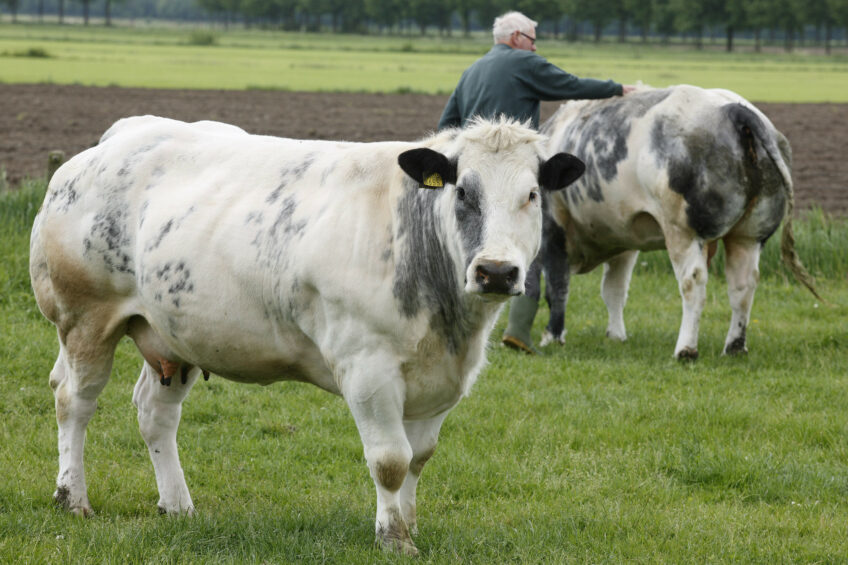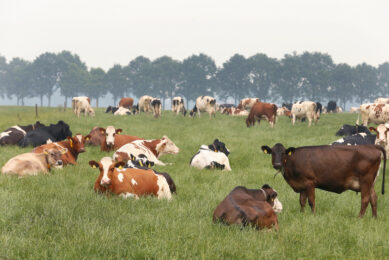Holsteins or Belgium Blue: Which one emits more methane?

Holsteins or Belgium Blue? Do these cows have a different rumen microbiota and hence show different levels of methane output?
The impact of intensive agriculture on climate change can for a large part be attributed to the production of greenhouse gases (GHG) by livestock breeding. GHG emissions form agricultural practices accounted for 8.5% of the total Belgian emissions in 2014. 45% of these emissions could be attributed to methane production during enteric fermentation by cattle (NIR, 2017). In Belgium, Holsteins and Belgium Blue make up most of the total cattle herd.

Experimental set up
Belgium researchers therefore wanted to know if these 2 different breeds also have a different rumen microbial community composition and methane emission. In the study, 8 Holstein Friesian (HF) and 8 double-muscled Belgian Blue (DMBB) heifers of similar age (averaging 23.3 ± 1.5 months) and gestation stage (averaging 6.5 ± 1.9 months) were co-housed in a free stall. At the start of the experiment, the HF and DMBB heifers had an average weight of 558 ± 39 kg and 594 ± 42 kg, respectively. Throughout the experiment, all heifers were fed the same diet to minimise dietary influences on the rumen microbial community and the methane production of the animals. The basal diet consisted of 40% maize silage, 40% grass silage and 20% grass hay (on dry matter basis) and was complemented with concentrate feed. Enteric CH4 and CO2 emissions (g d−1) were measured over a period of 6 consecutive weeks using the GreenFeed system.
Differences in DMI
It was shown that HF heifers had significantly higher absolute enteric methane emissions as compared to DMBB heifers. Methane production was positively correlated to the dry matter intake (DMI). Due to the significantly higher DMI and energy intake of HF heifers, methane yield per DMI was not significantly different between breeds. Furthermore, no significant differences were observed between the gross feed efficiency (GFE) of both breeds, but the DMBB heifers demonstrated significantly lower CH4:CO2 ratios (mole-to-mole ratio), suggesting a more efficient fermentation by the rumen microbial ecosystem.
Breed specific bacteria species
Although both breeds accommodated a common core of taxonomic groups, the bacterial communities also showed a breed specific composition due to differential abundance of specific species belonging to the main taxonomic groups and the presence of a few species of minor taxonomic groups that were significantly associated with one of both breeds. Abundant families as the Prevotellaceae, Lachnospiraceae, Ruminococcaceae, Spirochaetaceae (represented mainly by Treponema sp.), BS11 gut group and S24-7 (Bacteroidales) and the RC9 gut groups (Rikenellaceae) contained OTUs with differential abundance in both breeds. OTUs belonging to Coriobacteriaceae, Porphyromonas, Bergeyella, Candidate division TM7, Thalassospira, Mannheimia and Acinetobacter had higher relative abundances in DMBB heifers, whereas OTUs of RF16 (Bacteroidales), Fibrobacter, vadinBB60 (Clostridiales), Veillonellaceae (represented by Anaerovibrio and Selenomonas), Lentisphaerae, Planctomycetaceae and Succinivibrionaceae had higher relative abundances in HF heifers. In contrast to the bacterial communities, the methanogen community was consistent and stable between breeds and at different sampling times.
Conclusion
These results suggest that breed related factors influence the bacterial community composition, while the variation in methane emission levels can be attributed mainly to the feed intake of the animals.
Join 13,000+ subscribers
Subscribe to our newsletter to stay updated about all the need-to-know content in the dairy sector, two times a week.










